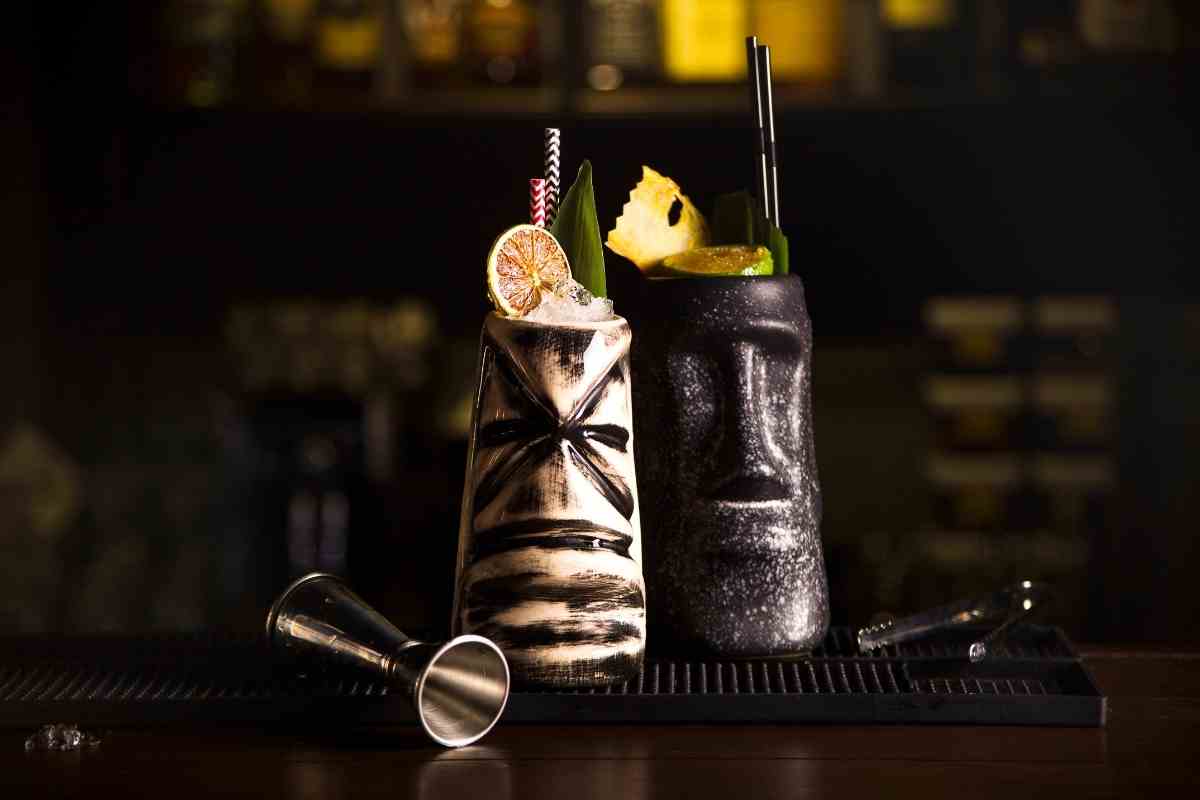Most people envisage a vacation on a warm beach, where they can sit sipping their favorite drinks while listening to slow-paced and soothing music.
You don’t have to spend thousands of dollars or travel many miles to have such experiences.
With a little time and resources, you can import the easy life of the islands by building a tiki paradise in your backyard.
You’ll never spend summers alone when your buddies get wind of your fancy project. Instead, exciting beach parties with several tropical drinks will become the norm.
What to Expect? Building a tiki paradise is an exciting project. You start with a basic framework and roof. However, the most exciting part is adding the right décor for the tiki experience – bamboo, palm fronds, rattan, tiki torches and totems, and Polynesian masks.
When the construction is complete, you can have endless nights out with your close friends.
What Do You Need?
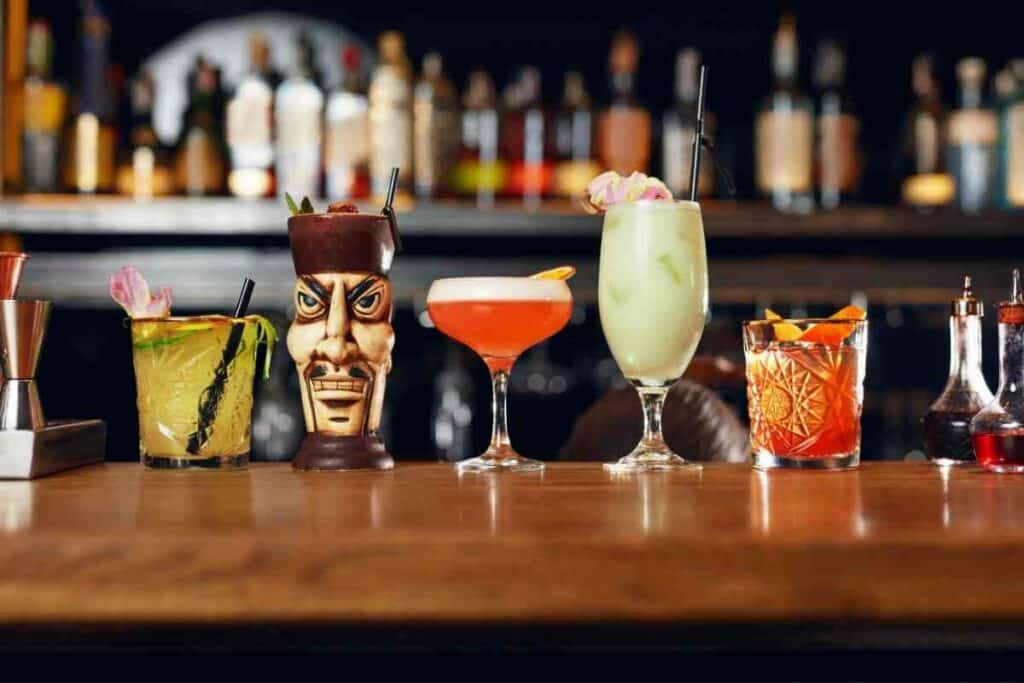
Here are the items you need to bring the ultimate tiki experience to your backyard.
Tiki torches
Lighting is a crucial element of indoor and outdoor décor.
If you want a tropical feel in your backyard, don’t use any light you encounter – insist on tiki torches.
When you light them up, these beauties will make your yard feel like a spot in the Polynesian islands.
Types of tiki torches
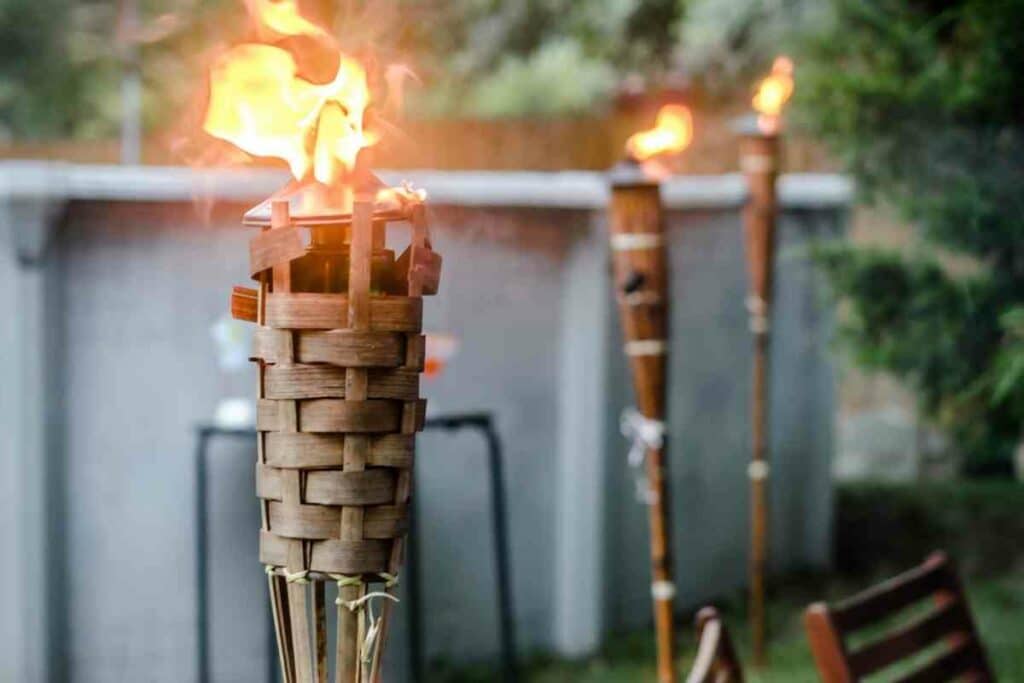
There are several types of tiki torches to suit different style preferences.
Common types include:
- floor torches
- hanging torches
- tabletop torches
- wall-mounted torches
Tiki torches can be traditional or electrical.
The former offers more authenticity with its flickering flames, while the latter provides convenience and ease of use.
Electric torches use either solar power or mains electricity. They are safer than torches with flames, making them ideal for homes with pets and kids.
The following are the most common types of tiki torches.
1. Floor torches
Floor torches bear the closest resemblance to traditional tiki torches.
They look like bowls attached to a pole or a stool.
As the name suggests, you place them on floors, which prevents them from toppling due to adverse weather.
On the Downside – Floor torches take up large spaces, making them unsuitable for small patios.
2. Hanging torches
Hanging torches are perhaps the most attractive type of tiki torches.
Moreover, you can place them in varying lengths to further beautify your tiki bar.
Unlike floor torches, hanging torches don’t take up a lot of space. They have hooks and handles that allow you to turn them anywhere.
3. Tabletop torches
Tabletop torches are ideal if you want to party late into the night.
By placing these lights on tables, visibility won’t be an issue. They also improve the ambiance and don’t take up a lot of space.
Additionally, tabletop torches have a flat base that increases stability and prevents toppling.
The most significant disadvantage of tabletop torches is that they illuminate small spaces because they are tiny.
4. Wall torches
As the name suggests, wall torches hang on walls.
You can also place them against fences and trees.
Most models have the screws, brackets, and other accessories needed for mounting.
If installed properly, wall torches are resistant to unwanted movements caused by adverse weather.
Factors To Consider Before Buying A Tiki Torch
Here are some factors you need to consider before buying a tiki torch.
Build material
The material used to construct a torch impacts its quality and sturdiness.
Ideally, the material should be tough enough to withstand harsh weather conditions so that you don’t have to invest in new torches frequently.
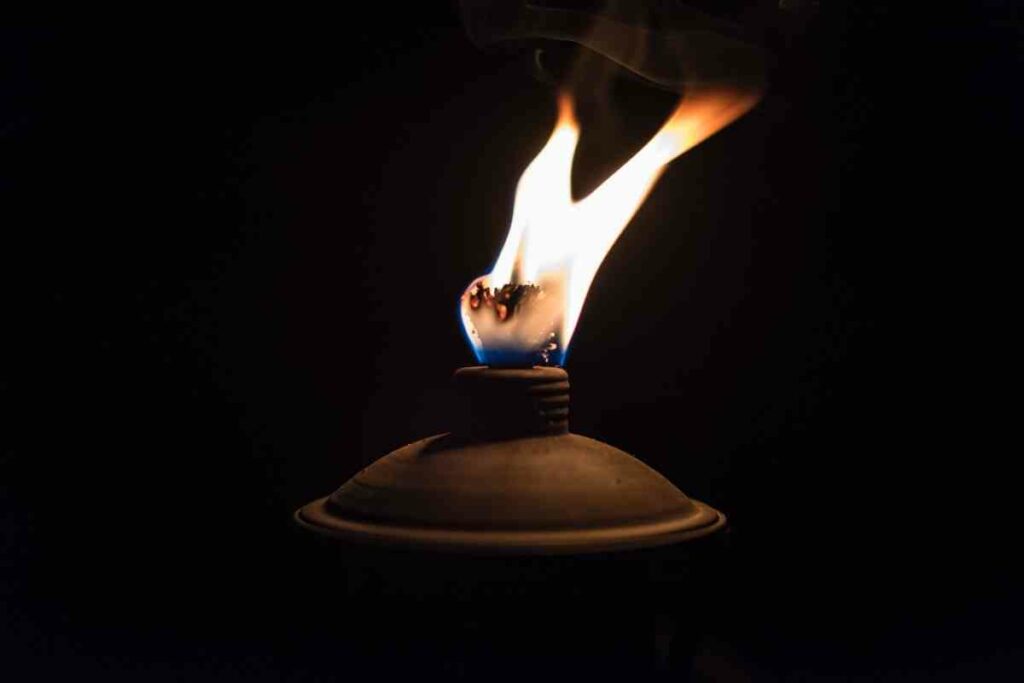
The most common materials used on tiki torches are:
- bamboo
- glass
- metal
Bamboo is classy, but it doesn’t match the sturdiness of metal.
On the other hand, glass is beautiful but brittle.
Ensure that you assess the pros and cons of each before choosing.
Cost
Tiki torches can be as cheap as $10 or as costly as $100.
The price depends on the material and type.
When shopping, don’t let the price judge you – examine the features to see if it’s a worthwhile deal.
Usually, cheap lights have the most basic features.
However, some models don’t offer value for money – you can see an overpriced unit whose parts don’t justify the cost.
Flame control
Like other fire sources, torches are risky and can cause damage if they get out of control.
Ensure that you buy a torch that allows you to regulate the flames’ size and intensity to suit your needs.
The torch must also have snuffers that enable you to extinguish the flame safely.
Oil compatibility
All tiki torches with live flames rely on lamps to illuminate your tiki bar.
However, they don’t all use the same oil, and most are oil-specific.
The most common oils used by tiki torches are:
- citronella
- isoparaffin
- paraffin
Each burns at its rate, so you must consider this when buying a torch.
Frozen banana leaves
If you desire an authentic tiki experience, swap your regular tablecloth for frozen banana leaves.
Besides being cheaper, these leaves add that tropical feeling you crave. The leaves are readily available in most local groceries and online stores.
Although freezing increases the leaves’ lifespan, it’s effective for a week.
You’ll need to invest in these leaves more often if you like regular partying.
Coconuts and tropical fruit
Coconuts and tropical fruits are a must-have to create a beachy feeling in your outdoor space.
Strewn whole coconuts, empty shells, and tropical fruits like kiwis, mangoes, papaya, and pineapple can act as the centerpiece of your table.
They are also a great snack if you have one too many drinks.
Tropical flowers
Tiki torches brighten up your bar, but you can make the atmosphere more colorful by adding bold-colored tropical flowers.
Orchids are the best because of their vibrancy and ease of care.
If you have a tight budget or lack time to water your plants, faux blooms can do a decent job.
Mini palm trees
Even if you don’t live by the beach, you can recreate the feel by growing mini palm trees.
Like flowers, they add color and life to your tiki paradise.
However, their larger size means that they can be a focal point of attraction.
Here are some popular mini palm trees that can spruce up your tiki experience.
Pygmy Date Palm
The pygmy date palm is beginner-friendly, grows up to 10 feet tall, and spans four feet wide.
Its leaves resemble chicken feathers.
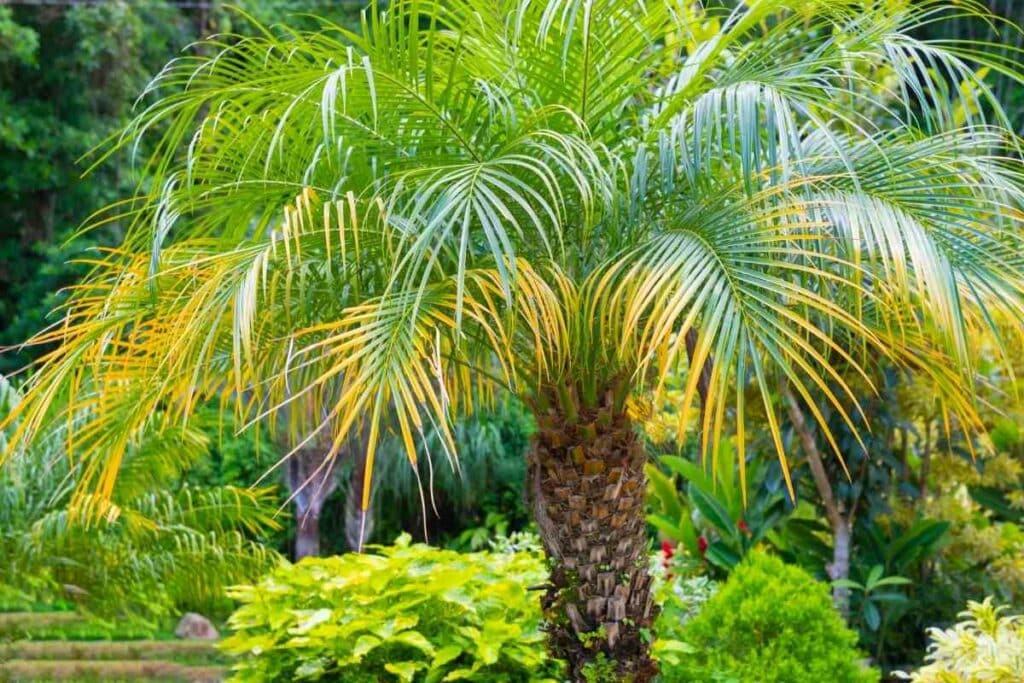
You can grow this species indoors and outdoors, provided it’s in a sunny spot.
However, this plant goes dormant when exposed to temperatures below 30 degrees Fahrenheit.
When Blooming – It produces vibrant, yellow flowers that add color to your tiki bar. The blooms later fall off to give way to purple dates.
Needle palm
Like the pygmy, needle palms are easy to care for and suitable for inexperienced growers.
Moreover, the plant is resilient and adapts to different climates and soils.
The plant gets its name from its stems, which look like needles.
A mature needle Palm can grow up to six feet tall and six feet wide. It’s a great option if you like symmetrical arrangements.
The leaves produce red drupes and tiny flowers with varying hues: brown, purple, white, and yellow.
Cat palm
If you’d like a mini palm tree that thrives indoors, the cat palm is a perfect choice.
The plant grows well in pots, provided you don’t expose it to direct sunlight and keep the temperatures between 50 and 80 degrees Fahrenheit.
When mature, a cat Palm can reach five feet tall, and its leaves cover a width of up to four feet.
Additionally – The cat palm requires little maintenance. It needs well-draining soil and feeding and watering once monthly.
Sago palm
The sago palm is among the slowest growing palm species.
Although it can reach 10 feet tall and wide, the plant can take up to five decades to attain that size.
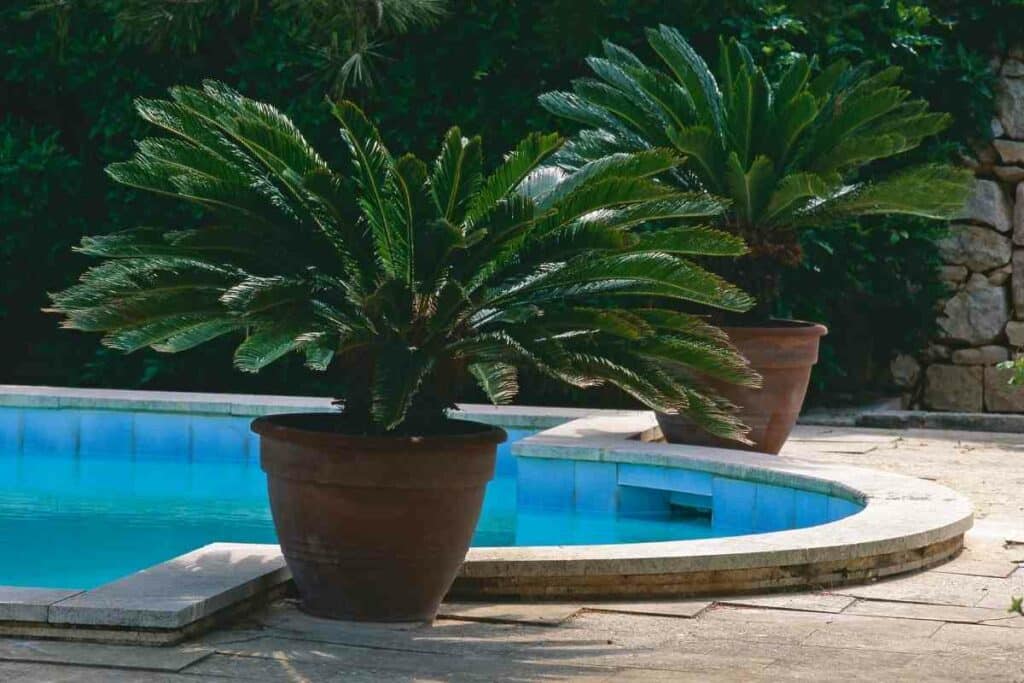
Another peculiarity of this breed is its inability to bloom.
Instead, it has beautiful green foliage that resembles feathers and grows symmetrically.
Sago palms thrive in warm and well-lit conditions, away from direct sunlight. The plant is relatively hardy but needs well-draining soil.
Ensure that you check water levels to avoid saturating the soil.
Parlor palm
Parlor palms can grow up to 12 feet tall.
They have stems that look like bamboo.
Since it’s a tropical palm, this small breed grows best in medium to bright indirect sunlight.
Interestingly, you can use your body to tell if the conditions are suitable for your parlor palms.
If the ambient temperature is desirable, it also favors your palm trees.
Regarding Maintenance – You must water parlor palms at least once weekly and repair them every four months. Although it produces fruit, it isn’t safe for human consumption.
Tiki Totems
Do you want to decorate your tiki bar with majestic and authentic décor that epitomizes the tropical allure of Polynesian culture?
If so, you must have tiki statues lining up the interior of your outdoor deck or patio.
You can make the most of limited space by investing in totems featuring many art pieces.
Tiki totems are a combination of several masks and statues used by ancient Maoris to represent various deities and bestow specific traits on the place they sit.
These masks have a much deeper meaning than a decoration – for example:
- some protect against evil spirits
- while others are thought to promote positivity by increasing peace, harmony, and excitement.
Each tiki mask is handcrafted from wood, and no two masks are identical.
Artisans must be careful when carving these masks because each has a unique facial appearance that represents the kind of traits it bestows.
Although tiki masks have existed for centuries in their native lands, they became popular in the western world in the 20th century.
With the increased adoption of the tropical Polynesian culture, more bars, cafes, and restaurants have these magnificent pieces in their interior décor.
Wall masks
Like tiki totems, wall masks bear spiritual significance to the originator of the tiki culture.
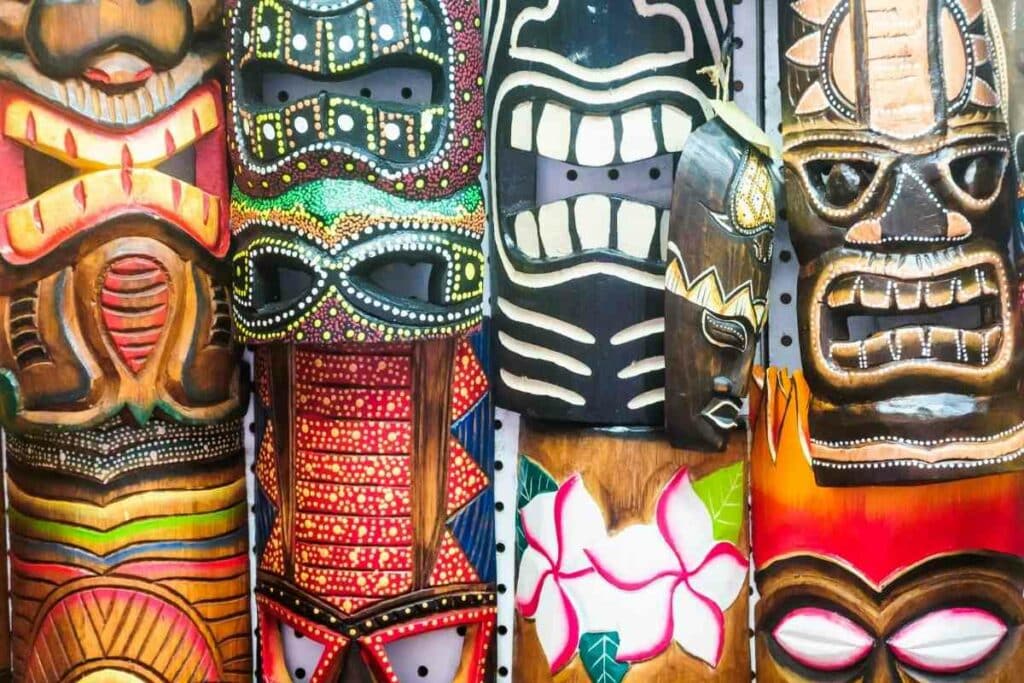
They might not be as stylish as those in the Enchanted Tiki Room in Disneyland, but they can protect you against evil spirits, especially when you have drank one too many shots of strong drinks.
Bar Sign
As unimportant as it seems, a simple bar sign guarantees a better tiki experience.
The best signages are handmade, like the masks and totems.
You can have the carver engrave your name for a personalized touch.
How To Build A DIY Tiki Bar
As much as you love the tropics and the idea of spending vacations there, it isn’t always possible to be there.
You need to have loads of cash to spend quality time in the not so modestly priced tropical holiday destinations.
If you aren’t lucky to live by the beach, the best you can do is recreate one at your home.
Read on to discover how to build a DIY tiki bar.
You’ll need:
- pieces of wood
- nails
- measuring tape
- screw
- filler
- polyurethane coating
- and other regular construction material
Then, follow the steps below.
Start with building the base
Use the saw to cut the wood you’ll use to make the base of your tiki years.
A typical base has three faces – one on the front, which is the largest, and two equal ones on either side.
The backside is usually left open for creating shelves.
Make the countertop
Next, topple the base to stand on one of the sides.
Place a large piece of wood that runs across from one side to another, such that it overlaps by a few inches on either side.
Make a mark on this piece of wood and then use a saw to cut it out.
Return the base to an upright position. Place the cut piece of wood, leaving room for overhang on all four edges.
Have an assistant press down on the wood to see if it can withstand pressure. If it does, nail it in place.
Later, apply exterior filler on the countertop edges and leave it to cure. Use sandpaper to sand the edges down until they become smooth.
Lastly, paint the countertop with your preferred enamel spray paint.
Make the roof
The final step of constructing a tiki bar is making the roof.
Here, you screw four pieces of wood against the two sides of the base.
Add another piece on the top to support the roofing material, which is mainly thatch grass.
After Roofing – Add a bamboo screen to face the bar. This is where most of your décor goes, including totems, statement pieces, and wall masks.
Once you complete these steps and add decorations like torches, masks, totems, palm trees, and tropical fruits and flowers, your guests won’t want to leave whenever you invite them into your tiki bar.
Wrapping Up
Living deep in the countryside isn’t an excuse to miss out on the tropical experience many people crave.
Tiki bars are cheap and easy to construct, and they add functionality to outdoor spaces.
